Potrebujeme váš súhlas na využitie jednotlivých dát, aby sa vám okrem iného mohli ukazovať informácie týkajúce sa vašich záujmov. Súhlas udelíte kliknutím na tlačidlo „OK“.
ASTM C1220-10
Standard Test Method for Static Leaching of Monolithic Waste Forms for Disposal of Radioactive Waste
Automaticky preložený názov:
Štandardná skúšobná metóda pre statické vylúhovanie monolitický odpad Formy na zneškodnenie rádioaktívneho odpadu
NORMA vydaná dňa 1.6.2010
Informácie o norme:
Označenie normy: ASTM C1220-10
Poznámka: NEPLATNÁ
Dátum vydania normy: 1.6.2010
Kód tovaru: NS-10089
Počet strán: 22
Približná hmotnosť: 66 g (0.15 libier)
Krajina: Americká technická norma
Kategória: Technické normy ASTM
Kategórie - podobné normy:
Anotácia textu normy ASTM C1220-10 :
Keywords:
cement leaching, ceramic leaching, glass leaching, leachate, leach test, nuclear waste, nuclear waste forms, nuclear waste materials, radioactive waste, simulated waste forms, static leach test, waste form durability, waste forms, Cement, Ceramic nuclear waste materials, Durability, Glass, Leachates/leaching, Monolithic waste forms, Nuclear scrap and waste materials, Radioactive waste materials, Simulated/radioactive monolithic waste forms, Static tests--environmental materials/applications
Doplňujúce informácie
| Significance and Use | ||||||||||
|
This test method can be used to provide a measure of the reactivity of a material in a dilute solution in which the test response is dominated by the dissolution or leaching of the test specimen. It can be used to compare the dissolution or leaching behaviors of candidate radioactive waste forms and to study the reactions during static exposure to dilute solutions in which solution feed-back effects can be maintained negligible, depending on the test conditions. The test is suitable for application to natural minerals, simulated waste form materials, and radioactive waste form material specimens. Data from this test may form part of the larger body of data that is necessary in the logical approach to long-term prediction of waste form behavior, as described in Practice C1174. In particular, measured solution concentrations and characterizations of altered surfaces may be used in the validation of geochemical modeling codes. This test method excludes the use of crushed or powdered specimens and organic materials. Several reference test parameter values and reference leachant solutions are specified to facilitate the comparison of results of tests conducted with different materials and at different laboratories. However, other test parameter values and leachant solution compositions can be used to characterize the specimen reactivity. Tests can be conducted with different leachant compositions to simulate groundwaters, buffer the leachate pH as the specimen dissolves, or measure the common ion effect of particular solutes. Tests can be conducted to measure the effects of various test parameter values on the specimen response, including time, temperature, and S/V ratio. Tests conducted for different durations and at various temperatures provide insight into the reaction kinetics. Tests conducted at different S/V ratio provide insight into chemical affinity (solution feed-back effects) and the approach to saturation. Either aerated or deaerated solutions may be used in this test method except when testing highly radioactive specimens. Deaerated solutions are mandatory in tests conducted with highly radioactive specimens to minimize the effects of nitrogen radiolysis. Preparation of deaerated leachants is addressed in 7.2.2. Control of the oxygen fugacity is not part of this test method. Such control and measurement may be required for specific uses of test data but are beyond the scope of this test method. Tests can be conducted using vessels compatible with the test specimen, leachant, and test environment. Corrosion resistant materials shall be used for tests with corrosive brines. Radiation-resistant materials shall be used for tests in radiation fields wherein the accumulated absorbed dose will exceed 104 rad (see Note 1). Note 1—Additional requirements to the test method apply when using a highly radioactive waste form specimen, as indicated in the procedure. |
||||||||||
| 1. Scope | ||||||||||
|
1.1 This test method provides a measure of the chemical durability of a simulated or radioactive monolithic waste form, such as a glass, ceramic, cement (grout), or cermet, in a test solution at temperatures <100°C under low specimen surface- area-to-leachant volume (S/V) ratio conditions. 1.2 This test method can be used to characterize the dissolution or leaching behaviors of various simulated or radioactive waste forms in various leachants under the specific conditions of the test based on analysis of the test solution. Data from this test are used to calculate normalized elemental mass loss values from specimens exposed to aqueous solutions at temperatures <100°C. 1.3 The test is conducted under static conditions in a constant solution volume and at a constant temperature. The reactivity of the test specimen is determined from the amounts of components released and accumulated in the solution over the test duration. A wide range of test conditions can be used to study material behavior, including various leachant composition, specimen surface area-to-leachant volume ratios, temperatures, and test durations. 1.4 Three leachant compositions and four reference test matrices of test conditions are recommended to characterize materials behavior and facilitate interlaboratory comparisons of tests results. 1.5 Specimen surfaces may become altered during this test. Although not part of the test method, it is recommended that these altered surface regions be examined to characterize chemical and physical changes due to the reaction of waste forms during static exposure to solutions. 1.6 This test method is not recommended for evaluating metallic materials, the degradation of which includes oxidation reactions that are not controlled by this test method. 1.7 This test method must be performed in accordance with all applicable quality assurance requirements for acceptance of the data. 1.8 The values stated in SI units are to be regarded as standard. No other units of measurement are included in this standard. 1.9 This standard does not purport to address all of the safety concerns, if any, associated with its use. It is the responsibility of the user of this standard to establish appropriate safety and health practices and determine the applicability of regulatory limitations prior to use. For a specific hazard statement, see 7.3.2. |
||||||||||
| 2. Referenced Documents | ||||||||||
|
Podobné normy:
Historická
1.1.2013
Historická
1.6.2010
Historická
1.6.2010
Historická
1.1.2014
Historická
1.1.2012
Historická
1.6.2011
Odporúčame:
Aktualizácia technických noriem
Chcete mať istotu, že používate len platné technické normy?
Ponúkame Vám riešenie, ktoré Vám zaistí mesačný prehľad o aktuálnosti noriem, ktoré používate.
Chcete vedieť viac informácií ? Pozrite sa na túto stránku.


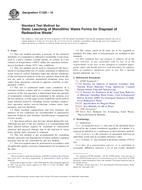
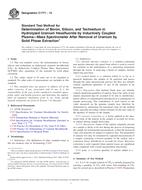 ASTM C1771-13
ASTM C1771-13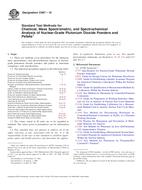 ASTM C697-10
ASTM C697-10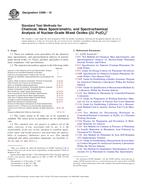 ASTM C698-10
ASTM C698-10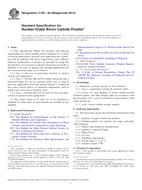 ASTM C750-09(2014)..
ASTM C750-09(2014)..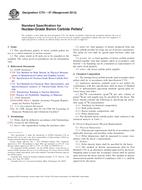 ASTM C751-07(2012)..
ASTM C751-07(2012)..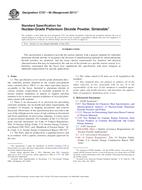 ASTM C757-06(2011)e1..
ASTM C757-06(2011)e1..
 Cookies
Cookies
